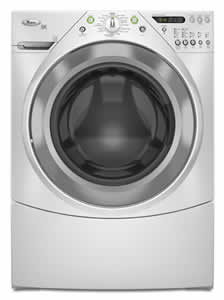Whirlpool Duet Ht Front Load Washer User Manual
Whirlpool Duet Front-Load Washer Guide. So your Duet washer has a gremlin?! Well that happens, a little too frequently if you ask me. The good news is Whirlpool Duet washing machines have a diagnostic mode to help troubleshoot what's the problem with your washer.
8
2. Once the bolt is loose, move it to the center of the hole and
completely pull out the bolt, including the plastic spacer
covering the bolt.
3. Once all 4 bolts are removed discard bolt and spacers. Then
pull the power cord through the opening of the rear panel and
close the hole with the attached cap.
4. Close the bolt holes with the 4 transport bolt hole plugs.
NOTE: If the washer is to be transported at a later date, call your
local service center. To prevent suspension and structural
damage, your machine must be properly set up for relocation by
a certified technician.
Connect the Inlet Hoses
Make sure the washer drum is empty.
1. Attach the hose with the red color indicator to the Hot (left)
inlet valve. Attaching the red coupling first makes it easier to
tighten connection with pliers. Screw on coupling by hand
until it is seated on the washer.
2. Attach the hose with the blue color indicator to the Cold
(right) water inlet valve. Screw on coupling by hand until it is
seated on the washer.
3. Using pliers, check the tightness of the hose couplings
already attached to the washer.
NOTE: Do not overtighten. Damage to the coupling can
result.
4. Attach the hose with the red color indicator to the hot water
faucet. Screw on coupling by hand until it is seated on the
washer.
5. Attach the hose with the blue color indicator to the cold water
faucet. Screw on coupling by hand until it is seated on the
washer.
6. Using pliers, tighten the couplings with an additional
two-thirds turn.
NOTE: Do not overtighten. Damage to the coupling can
result.
7. Turn on the water faucets and check for leaks.
NOTE: Replace inlet hoses after 5 years of use to reduce the
risk of hose failure. Record hose installation or replacement
dates on the hoses for future reference.
Periodically inspect and replace hoses if bulges, kinks, cuts,
wear, or leaks are found.
Route the Drain Hose
Proper routing of the drain hose protects your floors from
damage due to water leakage. Carefully read and follow these
instructions.
The drain hose is connected to your washer.
To prevent drain water from going back into the washer:
■
Do not straighten the drain hose, and do not force excess
drain hose into standpipe. Hose should be secure, but loose
enough to provide a gap for air.
■
Do not lay excess hose on the bottom of the laundry tub.
Floor drain
You may need additional parts. See Floor Drain under “Tools and
Parts.”
12
Using the Dispenser
Your new washer has a dispenser drawer with three separate
compartments for your laundry products—one is for detergent,
one is for liquid chlorine bleach, and one is for liquid fabric
softener. Laundry products are diluted and dispensed
automatically at the proper time during the wash cycle, making it
unnecessary for you to return to the washer during the cycle to
add them.
It is normal for small amounts of water to remain in the
dispensers when the wash cycle is complete.
Do not put laundry additives directly into the wash tub. Always
use the proper dispensers when adding laundry products.
Choosing the Right Detergent
For best washing performance, use a High Efficiency (HE), or
low-sudsing, detergent.
To fill dispenser compartments
1. Pull out the dispenser drawer.
2. Add the desired laundry product to the proper compartment.
3. Push in the dispenser drawer carefully and completely (to
avoid spillage).
Detergent compartment
(Letter C in Dispenser Illustration)
Add liquid or powdered HE detergent to this compartment for
your wash cycle. The detergent separator must always be in
place, either in the front or back position.
■
Do not fill beyond the “MAX” level.
■
Liquid or powdered color-safe bleach may be added to the
Main Wash compartment along with the same type of
detergent, liquid or powdered.
■
Liquid detergent: Put the SEPARATOR in the front position,
between the guides, as shown following. There will be no gap
between the bottom of the wash cycle detergent
compartment and the bottom of the separator.
■
Powdered detergent: Put the SEPARATOR in the back
position, behind the guides, as shown following. There will be
a gap between the bottom of the wash cycle detergent
compartment and the bottom of the separator.
NOTE: The separator will be in the POWDER (back) position
when shipped from the factory.
Bleach compartment
(Letter D in Dispenser Illustration)
Add NO MORE THAN
¹⁄₃ cup (80 mL) liquid chlorine bleach to this
compartment. The bleach will be automatically diluted and
dispensed at the optimum time during the first rinse after the
wash cycle. This compartment cannot dilute powdered bleach.
2012 Whirlpool Duet Washer Manual
■
Always measure liquid chlorine bleach. Use a measuring cup
with a pour spout; do not guess.
■
Do not fill beyond the “MAX” level. Overfilling could cause
severe garment damage.
Fabric Softener compartment
(Letter E in Dispenser Illustration)
Add ¼ cup (60 mL) liquid fabric softener to this compartment.
Fabric softener will be automatically dispensed in the final rinse.

■
Do not fill beyond the “MAX” level.
Dispenser
A. Dispenser release lever
B. Separator
C. Detergent compartment
D. Bleach compartment
E. Fabric softener compartment
A
B
D
C
E
Separator in front position, between guides
A. Separator
B. Guide
Separator in back position, behind guides
A. Separator
B. Guide
LIQUI
Whirlpool Duet Sport Ht Manual
SO
A
B
LIQUI
SO
A
B